2016 Ducati XDiavel S First Ride Review

A cruiser only Ducati could build
What do the Diavel and the XDiavel have in common? According to Ducati, aside from six letters in their names, only brake calipers and tires. So, despite the similarities of the names – and even in profile – Ducati calls the 2016 XDiavel the company’s first true cruiser. Don’t think of this as a boardroom construction meant to fill in a particular check mark on a manufacturer’s list of necessary products. As Claudio Domenicali, the Ducati Motor Holding SpA Chief Executive Officer, said just this morning over breakfast, Ducati doesn’t focus-group its bikes to death. Instead, the company builds the bikes it wants, the bikes that scratch a creative itch, and lets the chips fall where they may.
2016 Ducati XDiavel S
| Engine | 19.0/20 |
| Suspension/Handling | 13.5/15 |
| Transmission/Clutch | 8.5/10 |
| Brakes | 9.0/10 |
| Instruments/Controls | 5.0/5 |
| Ergonomics/Comfort | 8.5/10 |
| Appearance/Quality | 9.25/10 |
| Desirability | 9.25/10 |
| Value | 8.5/10 |
| Overall Score | 90.5/100 |
The XDiavel is a perfect example of the Ducati design approach. First, the designers decided what constitutes a cruiser as seen through its research of the American market. Next, the designers processed the information through the filter of Ducati styling, technology and performance to settle on what the key features would be. In the case of the XDiavel, the cruiser traits are relaxed, low-speed riding, the call of travel, and a feet-forward riding position. On the Ducati half of the DNA, signature Italian style crafted with the latest engineering and delivering a hefty dose of performance. This folding together of the somewhat contradictory design goals is what puts the X in XDiavel.
The Heart of a Champion
While the engine is always important in a motorcycle, in cruisers it is the crown jewel, the centerpiece of the bike’s design while simultaneously being the heart of its functionality. The Ducati Testastretta DVT 1262 takes this to the extreme – in a most positive way. With the Multistrada 1200 engine as its starting point, Ducati’s engineers massaged and reshaped the L-Twin to a form more appropriate for Ducati-style cruiser duty. The 1262cc displacement comes courtesy of a longer stroke, yielding bore and stroke dimensions of 106.0mm x 71.5mm.
The DVT moniker in the name stands for Desmodromic Variable Timing, which first appeared in the Multistrada 1200 last year, where it varies the timing of both the intake and exhaust camshafts independently, allowing the engine to deliver the seemingly impossible bottom-end grunt and top-end oomph. (To learn about DVT, our 2015 Ducati Multistrada 1200 And 1200S First Ride Review has all the details – including video.)
Cruiser riders don’t normally spin their bike’s engine up to the rpm limit. Instead, they usually rely on the bottom-end torque as the primary motivating factor. Ducati have clearly studied this phenomena and have moved to address this with the XDiavel. The result is a claimed torque peak of 95 lb-ft at 5,000 rpm. While that rpm level may be a bit high for traditional cruisers – in fact, on many cruisers, that would be approaching the rev ceiling – the peak is significantly lower than on the previous Diavel and then remains relatively flat until 7,500 rpm.
However, what cruiser riders typically have not experienced is the soul-stirring, deep intake howl emitted as the Testastretta’s superbike roots come online, thrusting the XDiavel forward with such force that they’ll be thankful for the bolster at the back of the seat, since the feet-and-hands-forward riding position gives the rider very little with which to combat the acceleration other than upper body strength. But I’m getting ahead of myself.
Spy Shots: Ducati Diavel Gets A Makeover!
Compression was bumped from 12.5:1 on the MTS to a healthy 13:1 on the XDiavel. While the Bosch electronic injection system utilizes the same 56mm elliptical throttle bodies, the ride-by-wire (RbW) has, not surprisingly, been completely reworked. Ducati being Ducati, the engine also has a host of electronic goodies to provide the rider with a variety of power delivery options. The three riding modes are: Sport, Touring, and Urban – each of which also features distinct Ducati Traction Control (DTC) and ABS settings.
From a power delivery perspective, the Sport mode naturally brings all 156 horses into play with the relationship between the right grip and the throttle’s butterflies a 1:1 ratio, giving the most direct relationship with the rider. The DTC is also set to its least intrusive preset level. In Touring mode, the whole stable is still available, but at lower rpm the throttle response is softened by lessening the ratio of wrist input to throttle opening. However, as the rider opens the throttle further, the ratio changes to the point that, in the widest portions of throttle opening, it ultimately returns to the 1:1 ratio of Sport mode. Urban mode drops power output to 100 hp and further softens the throttle inputs to civilize the savage in the confines of the city – and presumably slippery conditions. DTC gets progressively more assertive with Touring and Urban modes.
Here’s where regular readers, who are familiar with my penchant for smooth throttle response, may be in for a surprise. In my quest for bobble-free on-off-on throttle transitions on the street, I am often willing to sacrifice a bit of power on the altar of smoothness. Frequently, I feel that RbW Sport mode is shorthand for abrupt mode, and Normal is actually the most streetable setting. Well, the XDiavel lays that belief to rest.
I began my day in San Diego’s morning traffic in Urban mode and found it to be friendly. Once the ride breached the city limits, Touring offered plenty of power with no feeling of disconnection between the grip and the rear wheel. I was content to ride like this for quite a while. However, when I switched to Sport, I was amazed at how smooth throttle transitions were. Deliberately shifting from acceleration to neutral throttle to acceleration to deceleration and back on the gas – mid-corner – were greeted with buttery-smooth power modulation with nary a hint of abruptness. The XDiavel stayed in Sport for the remainder of the day with the only exception being quick trips into the other modes to check their performance when we encountered different riding situations.
While we’re on the topic of power, let’s take a moment to consider the XDiavel’s output. While Ducati’s reps made much of the increase in torque in the bottom end of the rpm range when compared to the old Diavel – and it was there – the XD still doesn’t clear its throat until the tach clears 3,500 rpm. Below that, the engine will accelerate, but it also shudders as the cylinders try to deliver thrust from each power stroke. Above 4,000 rpm, it’s ready to rock. The Testastretta’s superbike powerplant gives riders the luxury of choosing two riding techniques. One can loaf along in a single gear rolling between 4,000 and 6,500 rpm content to use the engine as a giant rheostat, or if you’re in the mood for some shenanigans, drop down a gear or two and let the L-Twin pleasure you aurally. However, the real joy of the XD comes from turning the loud tap to 11 and holding on for dear life.
The forward thrust provided by the linear powerband up to those 156 horses is exciting. Add in the clamshell riding position in which your grip and upper body strength (plus an appreciated assist from the seat’s bolster) are the only things holding you on the bike, and you’re in for the ride of a lifetime. I’ve ridden a ton of hopped up cruisers, including a dual-supercharged Valkyrie, and no factory cruiser has ever widened my eyes to such an extreme. One of my compatriots topped the ton in third gear. In one instance, I saw a speed (with way more on tap) that would cause my father to call me with the reminder that I have young children that need me if I included it in this article.
Taming the Beast
The new electronic feature that has been the topic of much discussion amongst the MO staff is the DucatiPowerLaunch (DPL). This special launch mode is so cool that it gets its own button safely tucked away behind the front brake reservoir. Pressing the DPL button directs the rider to a screen with three choices. The first gives the least intervention in the form of DTC and Wheelie Control, while the third gives the most. Once the level of protection is selected, a screen tells the rider to place the transmission in first and crank the throttle WFO. Once you’re underway, the electronics take over to save your butt until you either reach 74.6 mph (120 km/h) or you shift to third gear. Also, it disengages if your speed drops to 3.1 mph (5 km/h). Other than stating that the DPL would only allow three launches before a prescribed cool-down period was enforced, the press briefing covered nothing else about this mode.
During one of the photo stops, I asked a ride leader if there was a place scheduled for us to try DPL for ourselves and was shocked to discover that we were not going to test it. The thought that I wouldn’t get to test DPL began to eat away at the back of my brain, like a rat gnawing on wiring inside a wall. Who were they to say that I shouldn’t fully test their new motorcycle’s capabilities? I’m a professional. Our readers deserve to know.
A few minutes later, after a photo pass, I found myself at a stop facing an eighth-mile of empty pavement and no Ducati officials in a position to stop me. Now, what would a MOron do in this situation? Yeah…
If you’ve spent any time at dragraces, you’ve seen racers crank the throttle to the stop, and, when the starting tree shows amber, dump the clutch. As my buddy, former coworker, and erstwhile editor for a dragracing magazine, Peter Jones puts it, in the classes that let you run multistage lock-up clutches or launch control, if you’re modulating your clutch at all, you’ve already lost. The parameters for the launch are programmed into the system in the pits. It was in this spirit that I selected DPL Level 3 for the most intervention (Hey, I’m not totally stupid!), pinned the throttle, and dumped the clutch.
DPL is not that kind of launch control.
Witnesses said, when they heard the engine roar, they turned their heads to see a cloud of tire smoke as the XDiavel’s rear tire instantaneously snapped to the right. Although DPL is not true launch control, I can firmly say that the DTC interceded on my behalf. Upon realizing my mistake, I immediately pulled in the clutch, but without the electronic assist, I would have started the 2016 testing season with a bang. An oops. And, I’m sure, a bunch of explaining. Instead, it was just a stratospheric adrenaline hit and a vigorous finger shaking by the Italian ride captain telling me that a second attempt would not be tolerated. Suitably chastened, I got back in line for another photo pass.
In summary, DPL requires human intervention on launch. Once it detects that the bike is moving, the DTC and wheelie control take over. The real perk that DPL brings to the party is holding the engine rpm at a preset level prior to launch. (For those who care: 8,500 rpm for Level 1 and 8,000 rpm at level 3.) Otherwise, the XDiavel owner is launching their bike the same way we did on our Sixway Street Suberbike Shootout: try not to bog the engine off the line then hold it wide open.
So, the Testastretta DVT 1262 is claimed to pump out 95 lb-ft and 156 hp (rated at its crankshaft) with transcendent throttle control, but cruiser engines are about more than the production of power. They are also highly-styled objects of worship, and Ducati expended tremendous effort to polish the mill to its jewel-like finish. First, the ugly cooling hardware covering a large part of the engine’s left side was relocated. The water pump moved from its former location on the alternator cover, a location that placed the multiple hoses required for routing the coolant in plain sight. Now, tucked in the center of the L, the water pump is driven by an additional belt and even had its output increased. The various pipes and hoses distributing the coolant have been repositioned, largely out of sight.
The finish of the engine varies based on whether it is a standard or S model XDiavel. The standard receives an all-black engine, while the S has machined highlights breaking up the engine’s glossy black belt covers. Additionally, other select S model pieces, like the peg mounting brackets and the outside edge of the 11 spokes on the alloy wheels, are machined to contrast the black paint. The S also receives a glossy black paint, as opposed to matte black, and a snazzy but understated textured grey and accenting red racing stripes down the center of the tank and front fender. Two other visual details round out the cosmetic features of the S: the LED daytime running light wrapped around the top of the headlight and the gold of the Brembo M50 brake calipers.
Functionally, the standard and the S are the same with the sole exception of the front calipers. The standard sports Brembo M4 32 radial monoblock calipers. Both bikes utilize 320mm semi-floating front discs. When used in anger, both sets of calipers provide plenty of usable performance, but if you want to see E-i-C Duke swoon, get him talking about his love of the M50s. The same holds true of the XDiavel S. But wait, there’s more: All XDiavels benefit from the Cornering ABS provided by the Bosch Inertial Measurement Unit (IMU), which “dynamically measures pitch and roll angles plus the speed of relative variations in attitude,” allowing the ABS unit to tune its response to the chassis’ current orientation and state of change.
A Ducati by any other name
Although we’ve hinted at the XDiavel’s styling, we haven’t yet turned our full focus on it. The primary design criteria were to embody the cruiser elements of a long, low stance and the almost omnipresent teardrop shaped tank then couple those with a feet-forward riding position. While the original Diavel had a sportbike-like bulbous-topped tank, the XDiavel displays a vestigial hump on its cruiser-styled teardrop. However, the abbreviated seat and pillion share more resemblance to a Monster seat than that of any cruiser. The best way to approach the XD’s relationship to cruiser aesthetics is to look at the broad strokes. The bike’s lines largely taper down towards the back. The engine is displayed in a frame designed to show its beauty and muscularity. The LED headlight is a minimalist unit that flows into the fork.
If the overarching lines are cruiser-ish, the execution is modern muscle. While this broadening of the cruiser palette to include reinterpretations of classic cruiser lines isn’t unheard of (look at many of the Victorys or the Vulcan S or even the Indian Scout, to a lesser extent), the XDiavel is Ducati performance focus laid over a cruiser profile. And then there are the forward controls that are so often the bane of cruiser cornering.
Ducati’s claim of a 40° lean angle and a relatively low 29.7-in. seat height with forward controls raised some eyebrows, but Ducati seems to have pulled it off. Additionally, the pegs can be moved approximately one inch forward and aft of the standard position to accommodate different leg lengths. Also, the extenders required to lengthen the shifter linkage to suit the varying peg positions are included with the bike. Accessory mid-mount pegs are available for those who want the XD to have the same foot placement as the Diavel. In true cruiser fashion, upper body strength is required for the rider to lift the glutes skyward when large bumps are encountered.
Speaking of bumps, the XDiavel’s suspension does a remarkable job of impersonating a sportbike in cruiser’s clothing. The ride is sporty firm which helps with the lean angles the XD can attain. The fully-adjustable inverted fork feels just about perfect for this bike, but the preload and rebound adjustable shock can get harsh over larger bumps (an issue typical of fat and therefore heavy rear wheels and tires –Ed.) – which wouldn’t be a problem if peg location allowed the rider’s legs to be used as auxiliary shock absorbers.
The idea of Ducati making a feet-forward cruiser, on its surface, defies logic. How could a company known for producing technologically advanced, narrowly focused sporting machinery even consider the function-defying riding position? However, what we get in the XDiavel is a modern interpretation of a performance cruiser that corners like a sporty bike and is capable of heart-thumping acceleration followed by hair-on-fire braking.
2016 Ducati XDiavel
+ Highs
- Torque!
- Followed by horsepower!
- 40° of available lean angle
– Sighs
- Harsh-ish rear suspension
- Riding position not optimal for handling the Testastretta’s acceleration
- You call that a pillion?
Cross-breeding Ducati’s vision of the American cruiser with the essential elements of Ducati has produced a bike that, in many ways, thwarts description. The XDiavel has a stunningly beautiful engine that looks much cleaner with the cooling plumbing tucked away from sight. Any other manufacturer would most likely have study-grouped the personality out of the XD. However, Ducati, by pursuing the company goal of building the kind of bikes that it as an entity wants to create, has produced an exciting bike that is one part cruiser to two parts performance machine.
Will the cruiser market accept the XDiavel? Only time will tell. The XDiavel and the XDiavel S will be available early March 2016 for a MSRP of $19,995 and $22,995, respectively.
2016 Ducati XDiavel and XDiavel S Specifications | ||
|---|---|---|
| XDiavel | XDiavel S | |
| XDiavel | XDiavel S | |
| MSRP | $19,995.00 | $22,995.00 |
| Engine Type | Ducati Testastretta DVT (Desmodromic Variable Timing), L-Twin, Dual spark, Liquid cooled | Ducati Testastretta DVT (Desmodromic Variable Timing), L-Twin, Dual spark, Liquid cooled |
| Displacement | 1262cc | 1262cc |
| Fuel System | Bosch fuel injection system, Full ride-by-wire system, 56mm oval throttle bodies | Bosch fuel injection system, Full ride-by-wire system, 56mm oval throttle bodies |
| Valve Train | 4 Desmodromically actuated valves per cylinder | 4 Desmodromically actuated valves per cylinder |
| Horsepower | 156 hp @ 9500 rpm (claimed) | 156 hp @ 9500 rpm (claimed) |
| Torque | 95.0 lb-ft @ 5000 rpm (claimed) | 95.0 lb-ft @ 5000 rpm (claimed) |
| Transmission | 6-Speed | 6-Speed |
| Final Drive | Belt | Belt |
| Front Suspension | 50mm inverted fork, adjustable for preload, compression, and rebound | 50mm inverted fork with DLC treatment, adjustable for preload, compression, and rebound |
| Rear Suspension | Single shock absorber, Adjustable preload and rebound, Remote reservoir, Single sided swingarm, 4.7 in. travel | Single shock absorber, Adjustable preload and rebound, Remote reservoir, Single sided swingarm, 4.7 in. travel |
| Front Brake | Dual 320mm semifloating discs, Radial Brembo monobloc 4-piston M4-32 callipers and radial master cylinder, Bosch cornering ABS | Dual 320mm semifloating discs, Radial Brembo monobloc 4-piston M-50 callipers and radial master cylinder, Bosch cornering ABS |
| Rear Brake | 265mm disc, 2-piston floating calliper, Bosch cornering ABS | 265mm disc, 2-piston floating calliper, Bosch cornering ABS |
| Front Tire | Pirelli Diablo Rosso II, 120/70 ZR17 | Pirelli Diablo Rosso II, 120/70 ZR17 |
| Rear Tire | Pirelli Diablo Rosso II 240/45 ZR17 | Pirelli Diablo Rosso II 240/45 ZR17 |
| Wheelbase | 63.6 in. | 63.6 in. |
| Seat Height | 29.7 in. | 29.7 in. |
| Weight | 545 lb. (claimed) | 545 lb. (claimed) |
| Fuel Capacity | 4.75 gal. | 4.75 gal. |
| Available Colors | Matte Black | Glossy Black |
| Warranty | Two years, unlimited mileage | Two years, unlimited mileage |

Like most of the best happenings in his life, Evans stumbled into his motojournalism career. While on his way to a planned life in academia, he applied for a job at a motorcycle magazine, thinking he’d get the opportunity to write some freelance articles. Instead, he was offered a full-time job in which he discovered he could actually get paid to ride other people’s motorcycles – and he’s never looked back. Over the 25 years he’s been in the motorcycle industry, Evans has written two books, 101 Sportbike Performance Projects and How to Modify Your Metric Cruiser, and has ridden just about every production motorcycle manufactured. Evans has a deep love of motorcycles and believes they are a force for good in the world.
More by Evans Brasfield




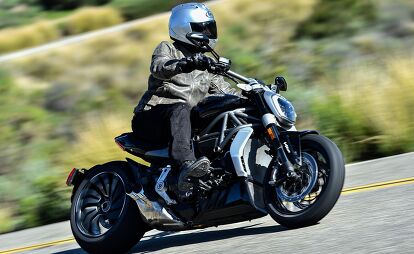




















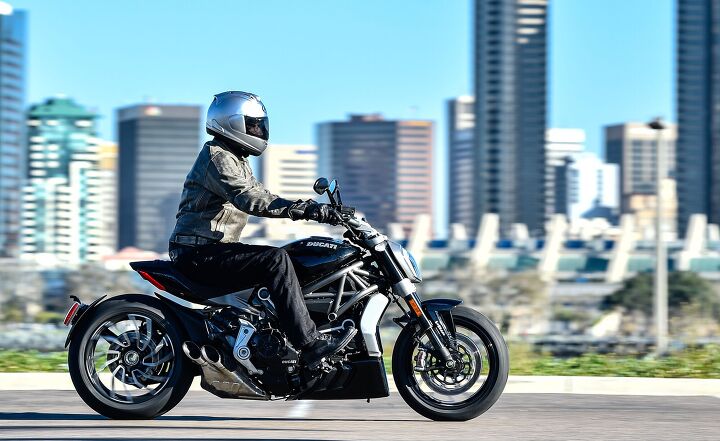








































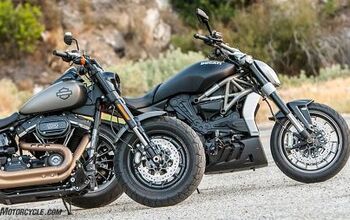
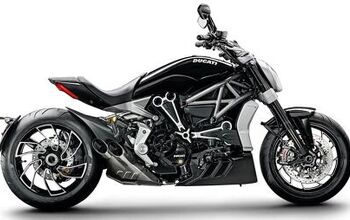


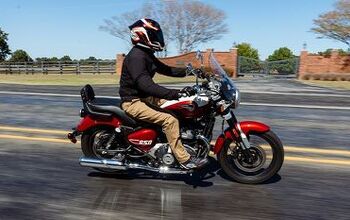











Comments
Join the conversation
The 2016 MOBO awards have lacked controversy. Perhaps, that speaks to the large number of outstanding motorcycles on the market. I'm hoping the XDiavel S wins cruiser of the year and/or motorcycle of the year. It's my favorite motorcycle to look at, and it doesn't really have a peer in the cruiser category.
xx